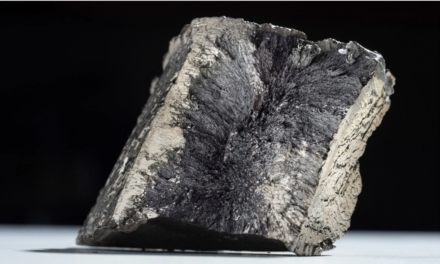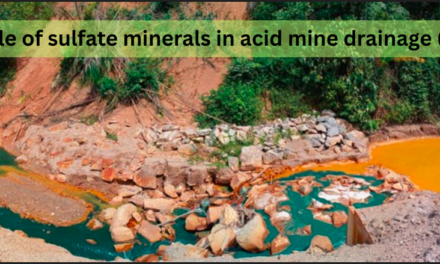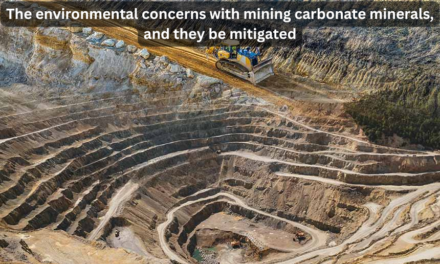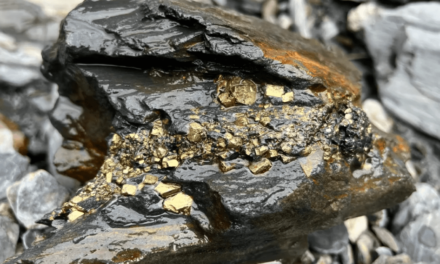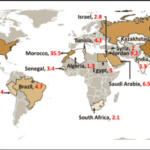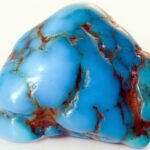Sulfide ore deposits form through geological processes that involve the interaction of metallic minerals with sulfur in the Earth’s crust. These deposits are typically found in hydrothermal environments, where hot fluids (often containing dissolved metals and sulfur) move through rocks and deposit minerals as they cool or react with surrounding materials. There are several primary processes involved in the formation of sulfide ore deposits:
1. Hydrothermal Processes
- Hot, mineral-rich fluids rise through cracks in the Earth’s crust, typically originating from magmatic intrusions (molten rock). These fluids often contain dissolved metals (e.g., copper, zinc, gold) and sulfur.
- As these fluids cool or react with surrounding rocks, metal sulfides (e.g., chalcopyrite, galena, sphalerite) precipitate and crystallize, forming sulfide deposits.
- These deposits can form in veins, replacement bodies, or disseminated zones within the rock.
- Key Example: Copper sulfide deposits like chalcopyrite are typically found in hydrothermal veins or as disseminated deposits in volcanic rock formations.
2. Magmatic Processes
- Sulfide ores can also form directly from magma during the cooling and crystallization of molten rock. Magmatic sulfide deposits occur when sulfide minerals (e.g., pentlandite, pyrrhotite) segregate from the molten rock and accumulate in mafic or ultramafic intrusions (high in iron and magnesium).
- These deposits are typically rich in metals like nickel, platinum, copper, and iron.
- Example: Nickel-copper sulfide deposits such as those in Sudbury, Canada and Norilsk, Russia.
3. Sedimentary Processes
- Some sulfide deposits form in sedimentary environments through the precipitation of sulfide minerals from bacterial action or chemical reactions in anoxic (oxygen-poor) conditions.
- This type of formation often occurs in shallow marine environments, where sulfur in seawater reacts with metals to form sulfide-rich sedimentary rocks.
- Example: Mississippi Valley-type (MVT) deposits of lead and zinc are formed in sedimentary basins.
4. Weathering and Secondary Enrichment
- Over time, surface weathering can break down primary sulfide ores, leading to the formation of secondary deposits. This process is known as supergene enrichment, where copper and other metals can become more concentrated near the surface.
- Weathered sulfide ores may produce secondary minerals like chalcocite (Cu₂S), which can then be economically extracted.
Major Global Sources of Sulfide Ore Deposits
Sulfide ore deposits are found in several key regions around the world, with some countries and regions being major producers of specific metals derived from sulfide ores. Below are the major global sources of sulfide ore deposits and their corresponding metals:
1. Sudbury Basin, Canada
- Key Metals: Nickel, Copper, Platinum Group Elements (PGE)
- Formation: The Sudbury Basin is a large magmatic sulfide deposit formed by a meteorite impact and subsequent magmatic processes. It is one of the largest sources of nickel and copper sulfides globally.
- Major Deposits: Nickel-copper sulfide deposits, including pentlandite, pyrrhotite, and chalcopyrite.
2. Norilsk-Talnakh, Russia
- Key Metals: Nickel, Copper, Platinum Group Elements (PGE)
- Formation: This is one of the largest magmatic sulfide ore districts in the world, with massive sulfide deposits in mafic-ultramafic intrusions formed from volcanic activity.
- Major Deposits: Rich deposits of pentlandite, pyrrhotite, chalcopyrite, and platinum group metals.
3. Copperbelt, Zambia and Democratic Republic of Congo (DRC)
- Key Metals: Copper, Cobalt
- Formation: The Copperbelt is a large, sedimentary-hosted copper-cobalt deposit, with sulfide ores forming in sedimentary basins under anoxic conditions. Copper sulfides, such as chalcopyrite and bornite, are abundant here.
- Major Deposits: Chalcopyrite, bornite, and cobalt-bearing sulfides.
4. Pilbara, Australia
- Key Metals: Copper, Gold
- Formation: The Pilbara region is home to several hydrothermal copper-gold deposits formed from volcanic and hydrothermal activity. Sulfide ores such as chalcopyrite and pyrite are mined for copper and gold extraction.
- Major Deposits: Chalcopyrite, pyrite, and gold-bearing sulfides.
5. Freiberg, Germany
- Key Metals: Silver, Lead, Zinc
- Formation: The Freiberg district in Germany contains Mississippi Valley-type (MVT) deposits, where lead-zinc sulfides are formed in sedimentary rocks.
- Major Deposits: Galena (lead sulfide), sphalerite (zinc sulfide), argentite (silver sulfide).
6. Bingham Canyon, USA
- Key Metals: Copper, Gold, Molybdenum
- Formation: Located in Utah, the Bingham Canyon deposit is a porphyry copper deposit, where copper sulfides (mainly chalcopyrite) are associated with molybdenite and gold.
- Major Deposits: Chalcopyrite, molybdenite, and gold-bearing sulfides.
7. Luba, Cuba
- Key Metals: Nickel, Cobalt
- Formation: The Nickel-Cobalt sulfide deposits of Cuba are associated with laterite deposits, formed through weathering and supergene enrichment of ultramafic rocks.
- Major Deposits: Nickel sulfides such as pentlandite and pyrrhotite.
8. Kambalda, Australia
- Key Metals: Nickel, Copper
- Formation: The Kambalda nickel sulfide deposits are formed through magmatic processes in ultramafic rocks. Nickel is the primary metal extracted from sulfide ores.
- Major Deposits: Pentlandite, pyrrhotite, chalcopyrite.
Conclusion
Sulfide ore deposits form through various geological processes, primarily in hydrothermal and magmatic environments, though they can also form in sedimentary settings. Major global sources of these deposits include regions like Sudbury, Norilsk, Zambia, Pilbara, and others, with important metals such as copper, nickel, zinc, lead, and gold being extracted from them. These regions play a vital role in supplying the raw materials needed for various industries such as electronics, energy, and construction


